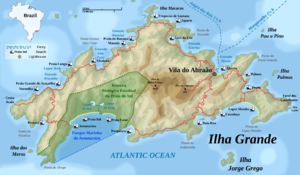Ilha Grande

View of Ilha Grande from the mainland
|
|
| English topographic map of Ilha Grande | |
| Geography | |
|---|---|
| Location | Atlantic Ocean |
| Area | 193 km2 (75 sq mi) |
| Highest elevation | 1,031 m (3,383 ft) |
| Highest point | Pico da Pedra D'Água |
| Administration | |
| Municipality | Angra dos Reis |
| State | Rio de Janeiro |
| Demographics | |
| Population | ~5000 (2014) |
Ilha Grande (Portuguese pronunciation: [ˈiʎɐ ˈɡɾɐ̃dʒi] "Big Island") is an island located off the coast of Rio de Janeiro state, Brazil. The island, which is part of the municipality of Angra dos Reis, remains largely undeveloped. For almost a century it was closed by the Brazilian government to free movement or settlement because it first housed a leper colony and then a top-security prison. Cândido Mendes high-security prison housed some of the most dangerous prisoners within the Brazilian penal system. It was closed in 1994. The largest village on the island is called Vila do Abraão with approximately 1900 inhabitants.
The island, which is 193 km2 (75 sq mi) in area, is now a popular tourist destination that is noted for its scenic beauty, unspoilt tropical beaches, luxuriant vegetation and rugged landscape. The highest point is the 1,031 m (3,383 ft) Pico da Pedra D'Água. Most of its territory is within the Ilha Grande State Park. The remainder of the island is subject to stringent development restrictions.
Ilha Grande is one of the most pristine remnants of Brazil's Atlantic rainforest making it one of the richest ecosystems in the world. As a hotspot for biodiversity and conservation, it holds some of the largest remaining populations of many endangered species, including the red-ruffed fruitcrow (Pyroderus scutatus), the brown howler monkey (Alouatta fusca), the maned sloth (Bradypus torquatus) the red-browed amazon parrot (Amazona rhodocorytha), and the broad-snouted caiman (Caiman latirostris). The seas around the island, which are also protected, feature a unique convergence of tropical, subtropical, and temperate-zone marine life, and may be the only waters in the world where it is possible to see corals and tropical fish along with Magellanic penguins and southern right whales.
...
Wikipedia

